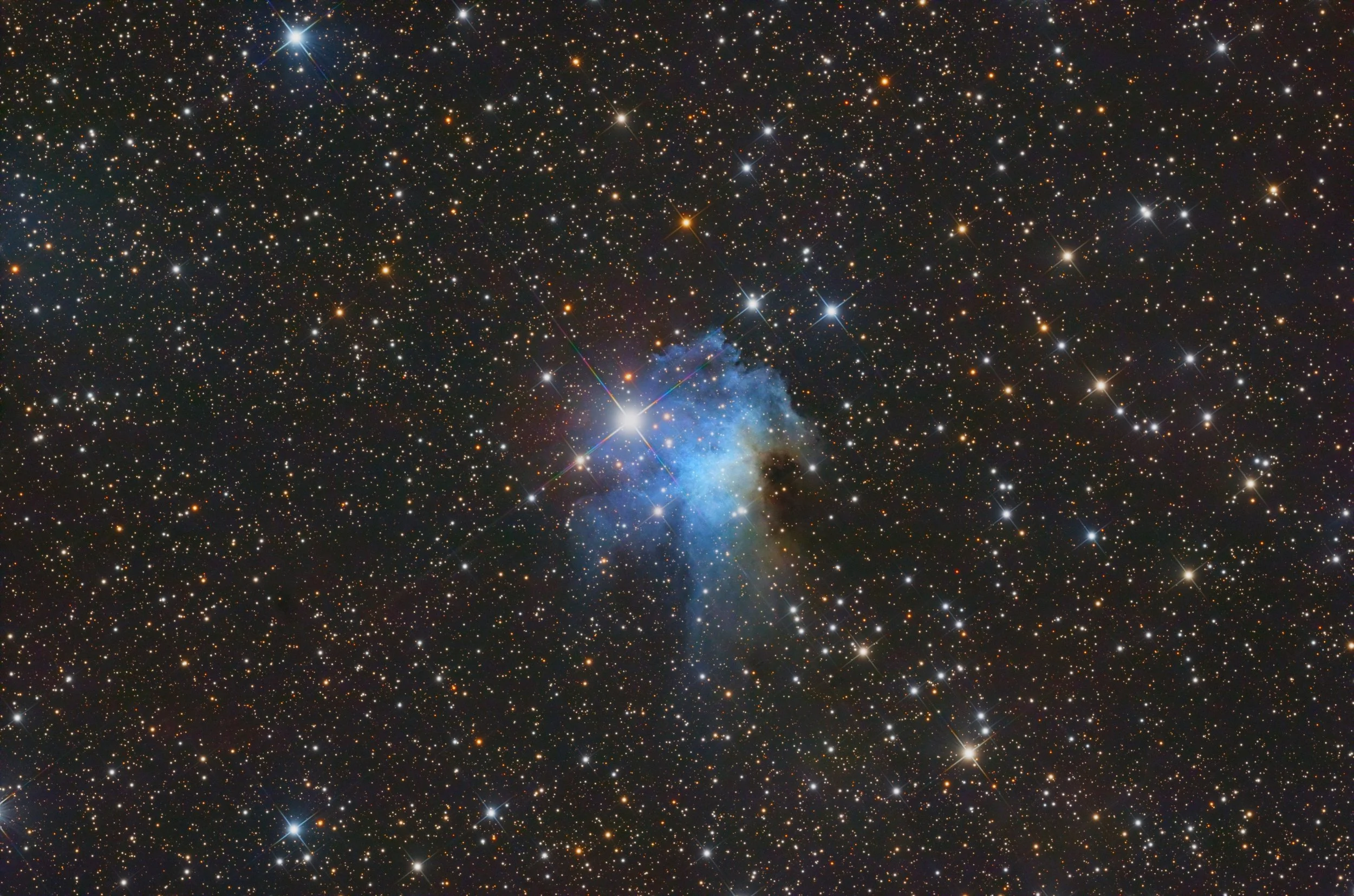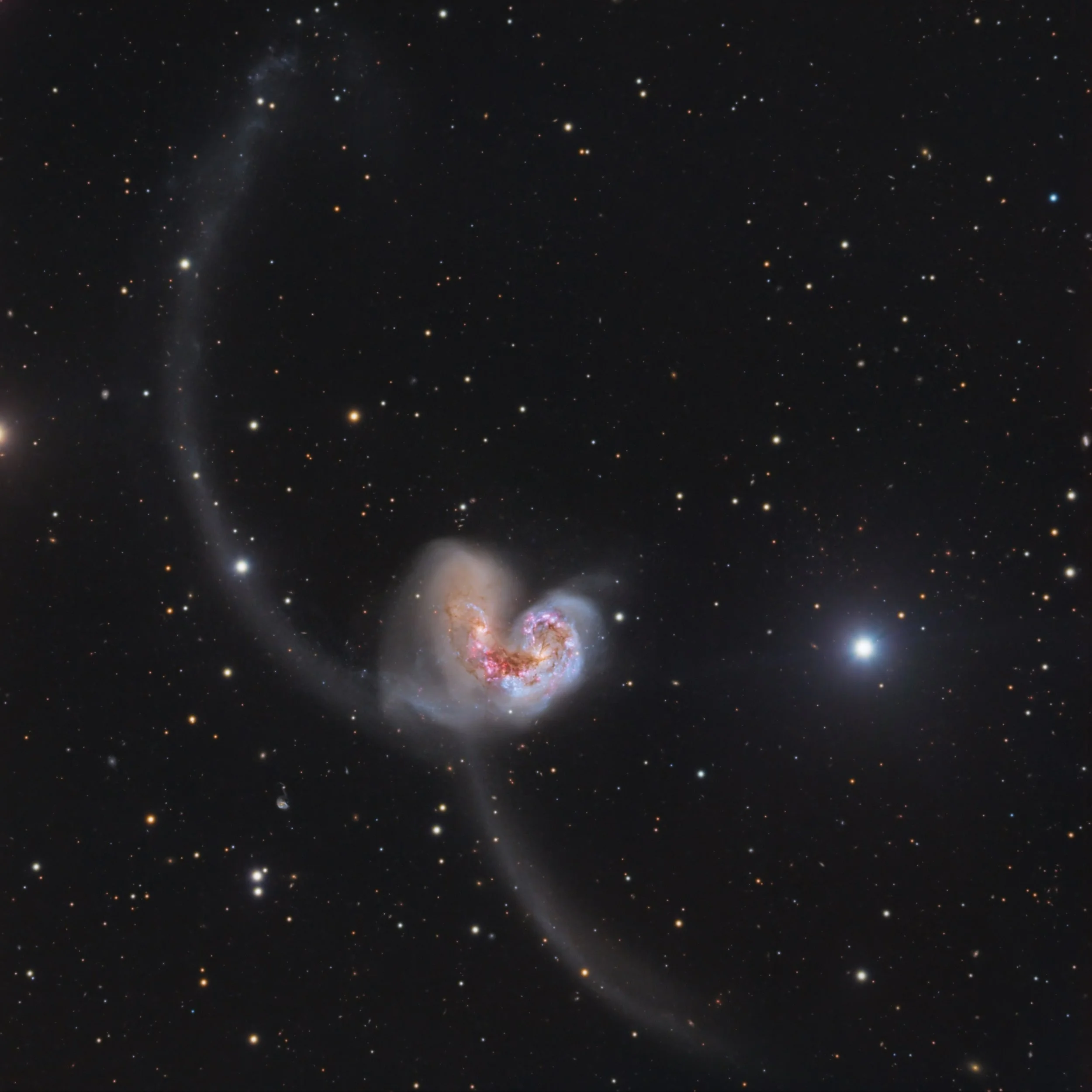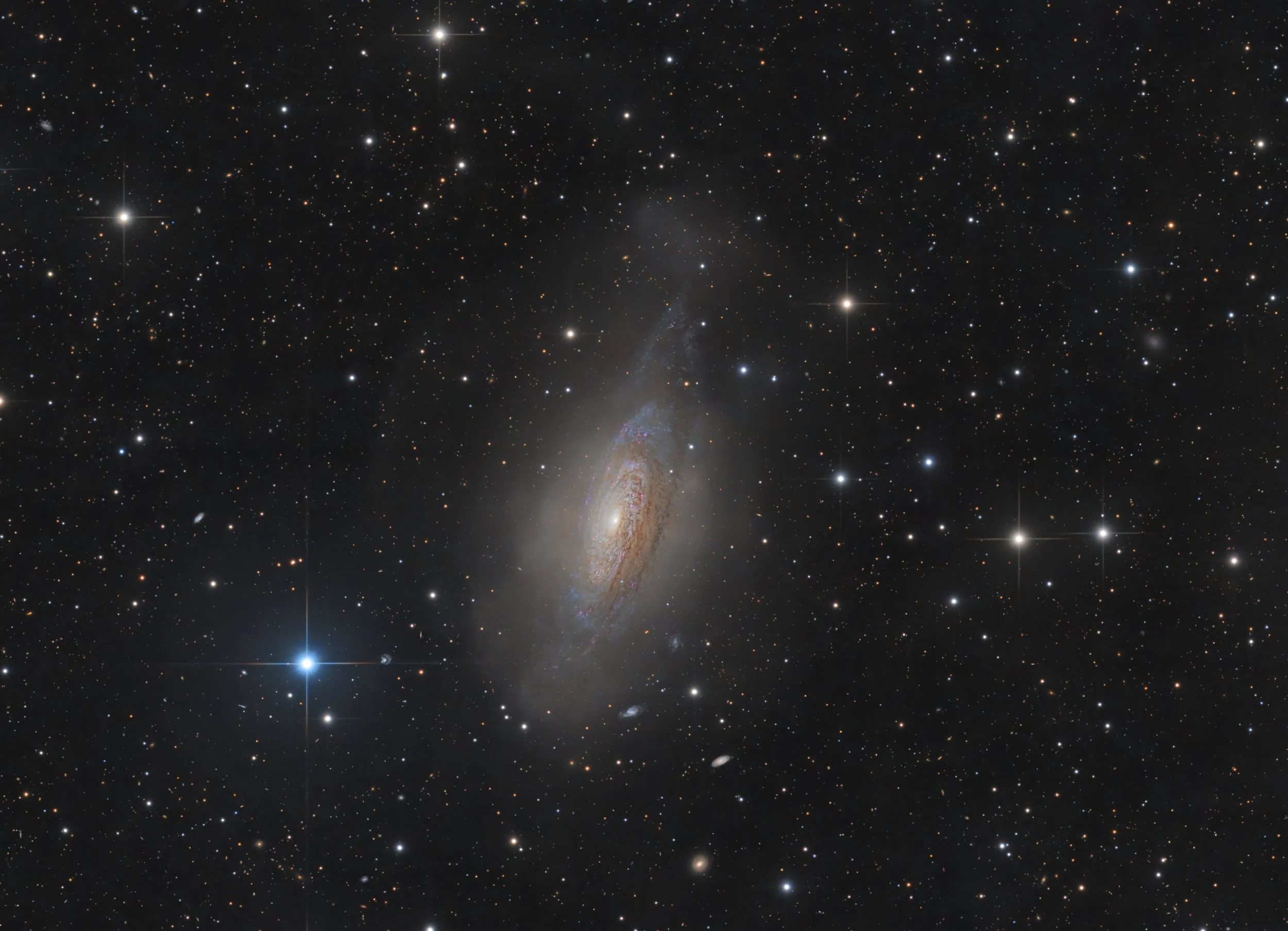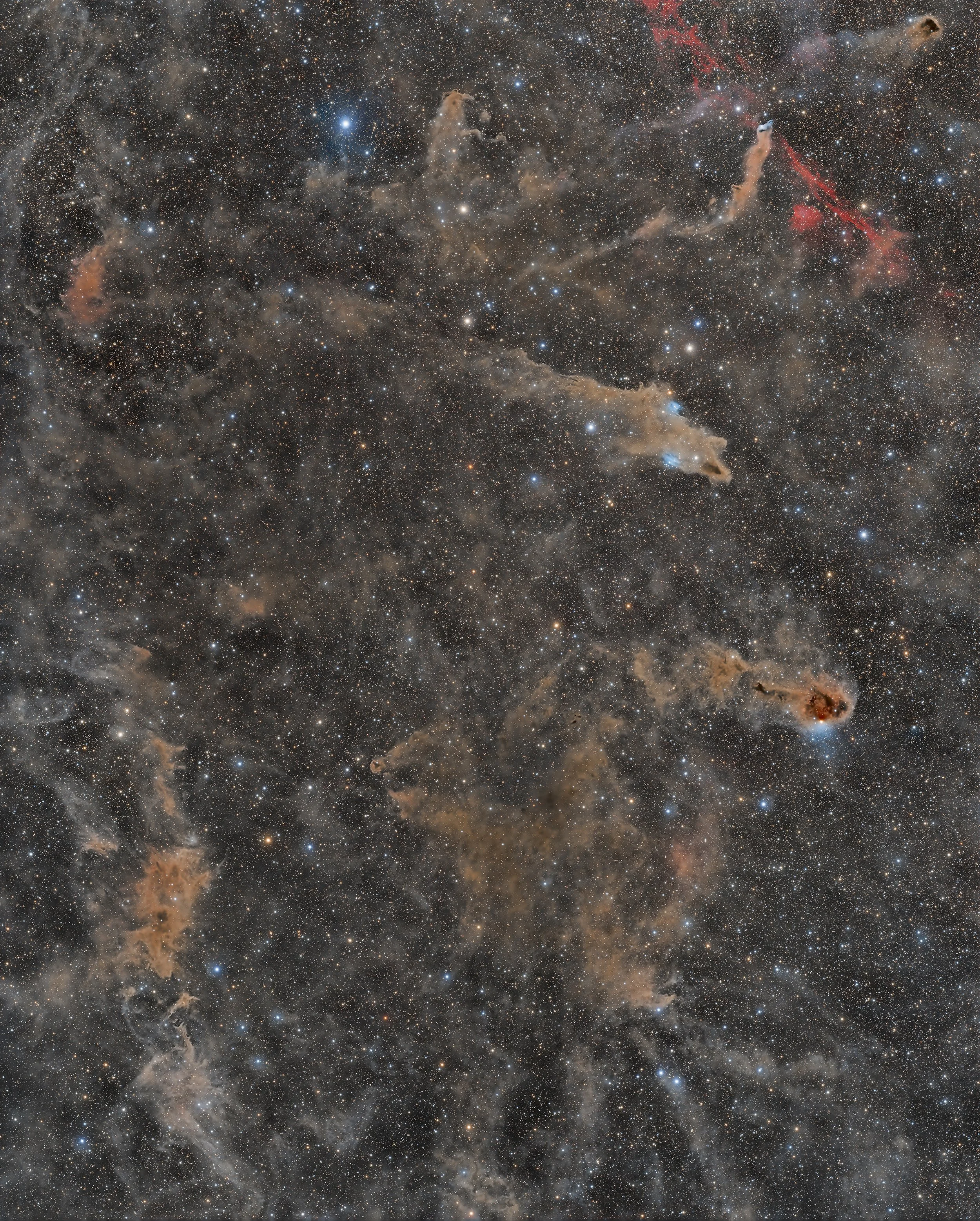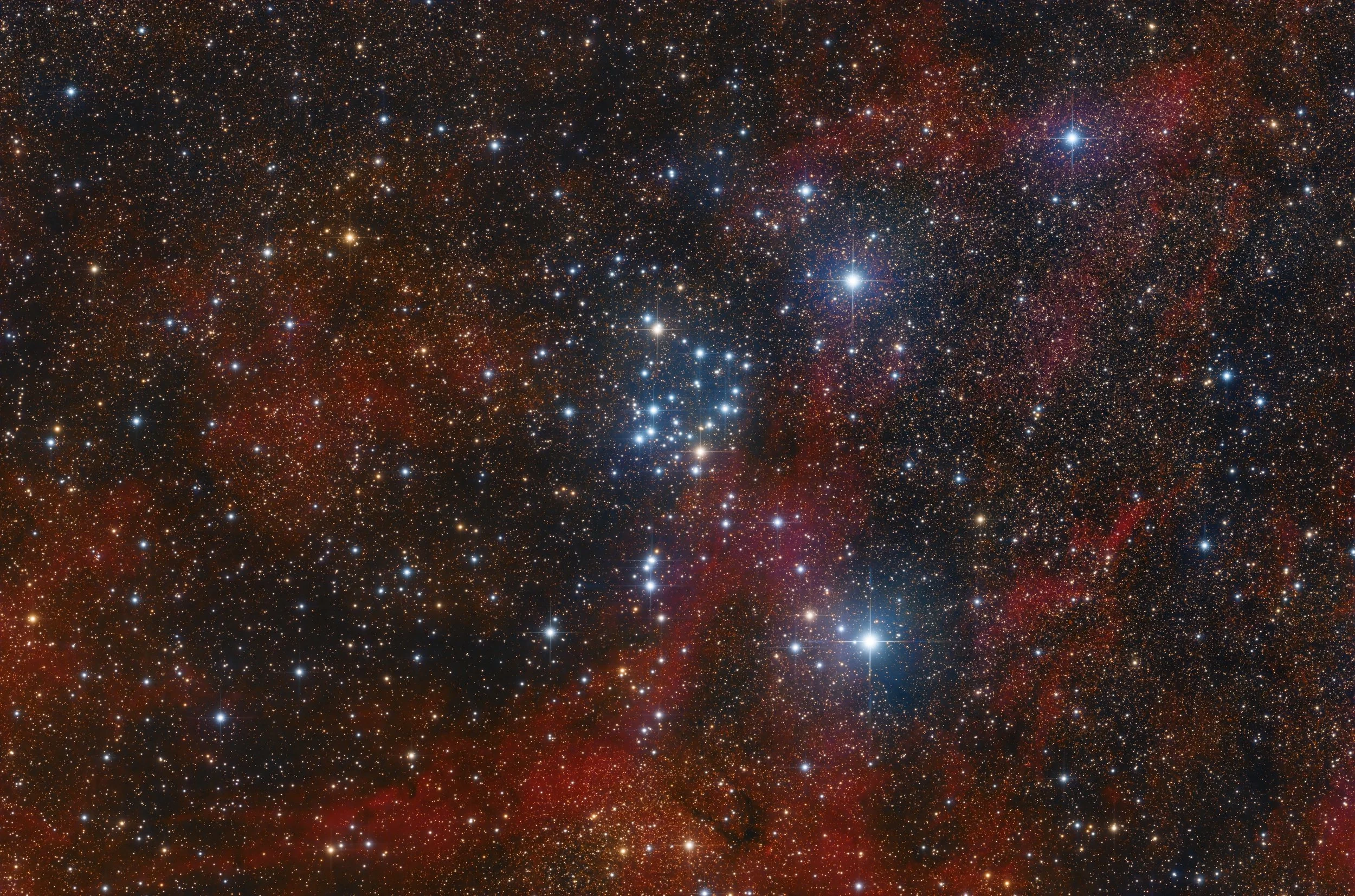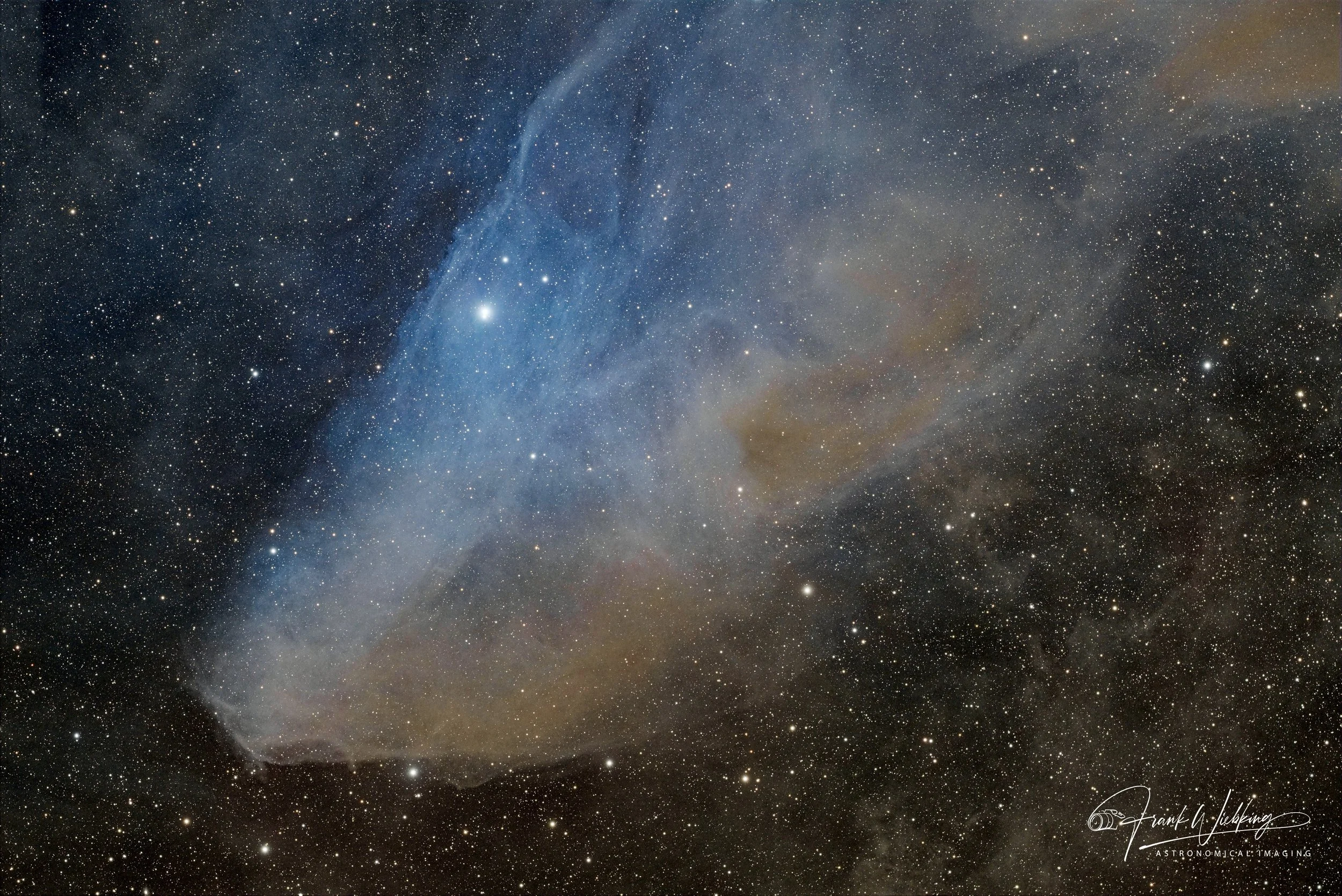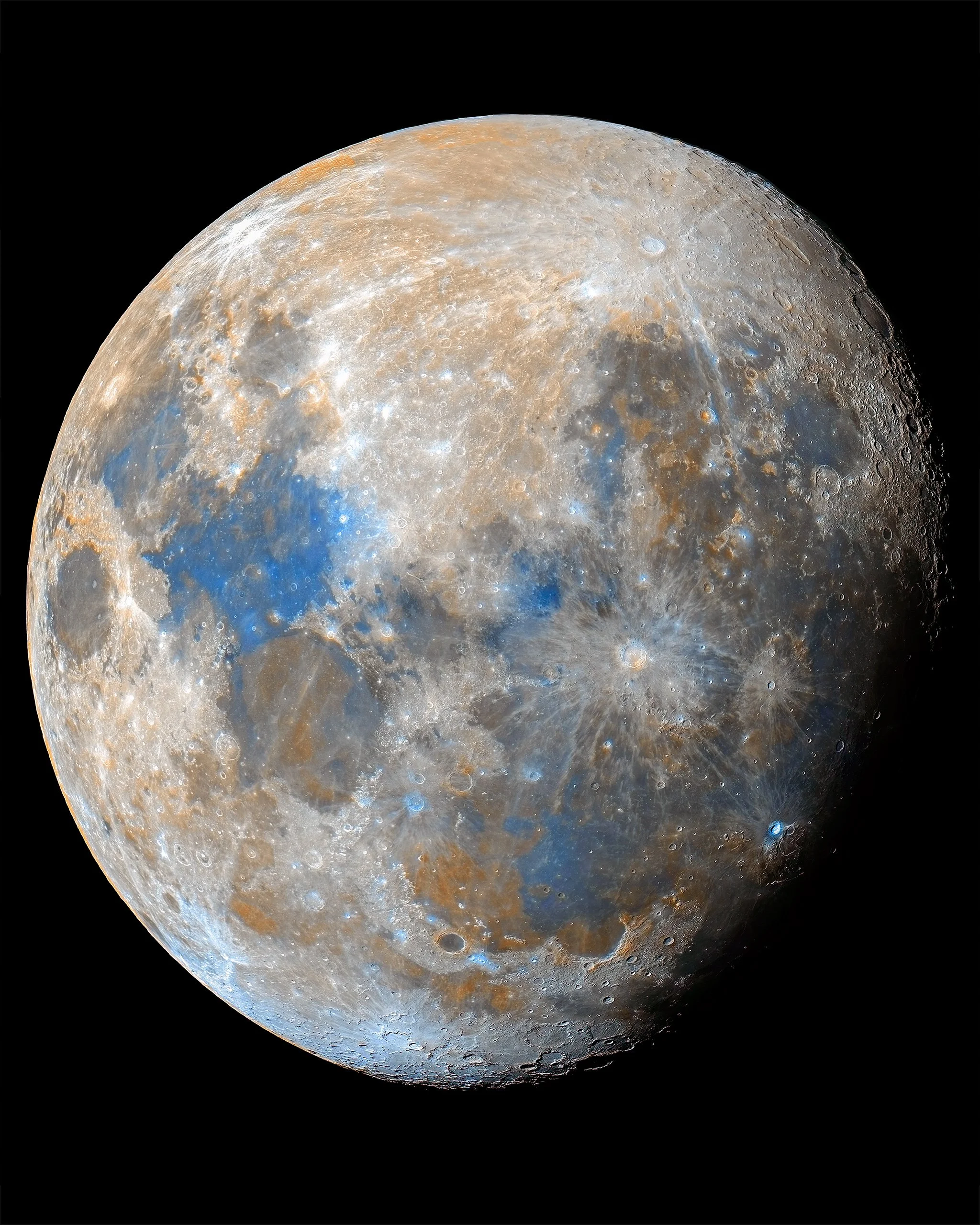
AAPOD2 Image Archives
IC-5076 LRGB
IC 5076 is a reflection nebula located in the constellation Cygnus, about 2,000 light-years from Earth. This nebula shines due to the light from nearby stars reflecting off its dust particles, rather than emitting light on its own. IC 5076 is surrounded by a rich star field typical of this region of the Milky Way, contributing to its striking appearance.
The LRGB imaging technique used here combines luminance (L) with red (R), green (G), and blue (B) color data to produce a vibrant, detailed image. The reflection nebula appears as a faint, bluish cloud, contrasting with the brighter stars that populate the background. The interplay between the dust and the starlight creates an ethereal view, highlighting the delicate structures within IC 5076.
LDN673 Dark nebula
LDN 673 is a striking dark nebula located in the constellation Aquila, approximately 600 light-years away from Earth. This region of space is rich with dense molecular clouds, where interstellar dust blocks the light from the stars behind it, creating a dark silhouette against the backdrop of the Milky Way. LDN 673 is part of a larger complex known as the Aquila Rift, an area of intense star formation activity.
In this image, the intricate patterns of the dark nebula are beautifully contrasted with the dense star field surrounding it. The thick clouds of dust and gas are where new stars are born, and their dark, winding shapes create a mesmerizing view. Despite the challenging nature of imaging such faint objects, this photograph captures the mysterious beauty of LDN 673, offering a glimpse into the dynamic processes that govern star formation in our galaxy.
ShaRA#9 – The Antennaee Galaxies
The Antennae Galaxies (NGC 4038 and NGC 4039) are a pair of interacting galaxies located about 45 million light-years away in the constellation Corvus. These galaxies are named for the long, antenna-like tidal tails of stars and gas that extend from the galactic cores, resulting from their dramatic collision and merging process. The Antennae Galaxies are in the midst of a significant starburst event, where the interaction has triggered the formation of millions of new stars, visible as bright blue clusters scattered throughout the galaxies.
This image of the Antennae Galaxies captures the chaotic beauty of the ongoing cosmic collision, highlighting the vibrant star-forming regions and the intricate tidal tails stretching into space. Although amateur astrophotography equipment may not match the resolution and detail of images taken by space telescopes like Hubble, the dedication and skill of amateur astronomers bring the wonder of these distant galaxies closer to home. The contrast between the dense galactic cores and the ethereal tidal streams showcases the dynamic and ever-evolving nature of the universe.
Mystical Heart of the Eagle
The Eagle Nebula, also known as Messier 16 (M16), is a young open cluster of stars in the constellation Serpens. Located about 7,000 light-years from Earth, this region is famous for its towering pillars of gas and dust, which are the birthplace of new stars. These iconic structures, known as the "Pillars of Creation," were famously imaged by the Hubble Space Telescope and are one of the most recognized features in the universe.
This amateur photo of the Eagle Nebula captures the ethereal beauty and intricate details of the region, showcasing the vibrant colors and delicate structures of the gas and dust clouds. While it may not achieve the same level of resolution and depth as the Hubble version, this image still provides a stunning view of the nebula's majesty. The amateur capture highlights the accessibility of astrophotography to enthusiasts and the ability to contribute meaningful observations, even in comparison to professional space telescopes.
Messier 39
Messier 39 (M39) is a beautiful open cluster located in the constellation Cygnus, the Swan. Situated approximately 800 light-years from Earth, this cluster is relatively close in astronomical terms. M39 is easily visible to the naked eye under dark skies and appears as a large, loose grouping of stars, covering an area about the size of the full moon.
This cluster consists of around 30 bright stars, most of which are blue-white in color, indicating their young age. Estimated to be around 300 million years old, M39 offers a stunning spectacle when observed through binoculars or a small telescope. The stars of M39 are spread out over a wide region, giving it a sparse, scattered appearance compared to more tightly packed clusters. This open cluster is a popular target for amateur astronomers, especially during the summer months when Cygnus is prominently positioned in the northern hemisphere’s night sky.
NGC7000 IC5070 MOSAIC
This stunning mosaic captures the North America Nebula (NGC 7000) and the Pelican Nebula (IC 5070), two prominent emission nebulae in the constellation Cygnus. Located approximately 1,600 light-years from Earth, these nebulae are part of a larger region of ionized hydrogen gas (H II region), creating a vibrant and colorful display in the night sky.
The North America Nebula, named for its resemblance to the continent, features distinct regions resembling the Gulf of Mexico, the eastern seaboard, and the west coast. The Pelican Nebula, adjacent to the North America Nebula, also has a recognizable shape, resembling a pelican with its long beak and curved neck. This mosaic image, created by combining multiple frames, highlights the intricate details and structures within these nebulae, showcasing dark dust lanes, bright emission regions, and areas of active star formation.
TWILIGHTS
This collection of images captures the breathtaking beauty of Sierra del Híjar, Cantabria, as seen through the different phases of twilight and the first hours of the night. Each phase, from sunset to astronomical twilight, reveals a unique aspect of this stunning landscape.
- Sunset: As the sun dips below the horizon, the sky is painted with vibrant hues of orange, pink, and purple, casting a warm glow over the rugged terrain of Sierra del Híjar.
- Civil Twilight: The sun is just below the horizon, and the sky retains a soft, pastel light. This is when the landscape is still clearly visible, and the first stars begin to twinkle.
- Nautical Twilight: The sky darkens further, with a deepening blue that marks the transition from day to night. The brighter stars and planets become more prominent, providing a guide for navigators.
- Astronomical Twilight: The sky is almost completely dark, with the last vestiges of sunlight fading away. This phase is perfect for stargazing, as the faintest stars and distant galaxies become visible.
- First Hours of Night: Complete darkness envelops the landscape, allowing the full splendor of the night sky to unfold. The Milky Way stretches across the heavens, and the constellations stand out in sharp relief against the dark canvas of space.
A panoramic view combining these different twilight phases offers a comprehensive visual experience, showcasing the gradual transition from day to night over the picturesque Sierra del Híjar. The serene beauty and tranquility of this natural spectacle highlight the stunning interplay of light and shadow across the landscape.
The Plasma Dance
This image of the Sun captures its current solar maximum phase, showcasing the dynamic and intense activity on its surface. The image was created by combining six days of solar prominence limb activity observed over the past two months. These prominences, which appear as bright loops and arches extending from the Sun's surface, are caused by the Sun's magnetic field and are particularly active during the solar maximum.
During a solar maximum, the Sun's magnetic field is at its strongest, leading to an increase in sunspots, solar flares, and prominences. This period of heightened activity, occurring roughly every 11 years, has a significant impact on space weather and can even affect satellite communications and power grids on Earth. This composite image provides a vivid representation of the Sun's dynamic behavior during this peak period, offering a stunning glimpse into the powerful forces at work on our closest star.
SNR G206.9+2.3 Supernova Remnant in the constellation Monoceros
SNR G206.9+2.3 is a stunning supernova remnant located in the constellation Monoceros. This image captures the intricate details and vibrant colors of the nebula, revealing the remnants of a massive star that exploded thousands of years ago. The nebula's structure is beautifully highlighted by the Ha and Oiii filters, which emphasize the regions of ionized hydrogen and oxygen, while the RGB filters add a natural color balance to the image.
Photographed at the Observatorio Remoto Desierto Cósmico in Atacama, Chile, this image benefits from the exceptionally dark skies of a Bortle 2.0 location. The total integration time of 24 hours and 15 minutes allowed for the collection of extensive data, bringing out the faintest details and the full grandeur of this celestial object. The resulting image is a testament to the beauty and complexity of supernova remnants, providing a glimpse into the life cycle of stars.
NGC 3521 - the Bubble Galaxy
NGC 3521, also known as the Bubble Galaxy, is a majestic spiral galaxy located in the constellation Leo. This galaxy is characterized by its bright core and the distinctive, bubble-like structures of its spiral arms. These features give it a unique appearance, making it a favorite target for astrophotographers and astronomers alike. The galaxy lies approximately 26 million light-years from Earth and spans about 50,000 light-years in diameter.
This detailed image of NGC 3521 was captured with a total exposure time of 22 hours and 21 minutes. The breakdown of the exposure times is as follows: 347 minutes for the luminance filter, and 85 minutes each for the red, green, and blue filters, with individual exposures of 120 seconds. This long integration time allowed for the capture of the intricate details and subtle structures within the galaxy, highlighting its vibrant colors and the delicate nature of its spiral arms. The result is a breathtaking view of the Bubble Galaxy, showcasing its beauty and complexity.
Into The Depths (LDN1235 - Dark Shark Nebula)
LDN 1235, also known as the Dark Shark Nebula, is a fascinating dark nebula located in the constellation Cepheus. This striking region of space resembles a shark swimming through the cosmos, with dark, dusty clouds obscuring the light from the stars behind it. The nebula is an area where interstellar dust and gas are dense enough to block visible light, creating a silhouette against the brighter background of the Milky Way.
This particular deep exposure of the Dark Shark Nebula was captured from a personal remote observatory in Trevinca, Spain. The detailed image reveals the intricate structure of the nebula, highlighting its dense, dark regions as well as the faint, surrounding wisps of interstellar material. The clear skies and advanced equipment at the Trevinca observatory allowed for an exceptionally detailed view, showcasing the beauty and complexity of this cosmic phenomenon.
NGC 5139 - Omega Centauri
NGC 5139, commonly known as Omega Centauri, is the largest and brightest globular cluster in the Milky Way. Located in the constellation Centaurus, Omega Centauri is about 15,800 light-years away from Earth and contains several million stars, making it one of the most massive and dense globular clusters known. This cluster spans over 150 light-years in diameter, and its stars range in age from 10 to 12 billion years, offering a glimpse into the early history of our galaxy.
Omega Centauri stands out not only for its sheer size but also for its complex stellar population. Unlike most globular clusters, which typically host stars of a similar age and composition, Omega Centauri contains multiple generations of stars. This suggests that it may have once been the core of a dwarf galaxy that was absorbed by the Milky Way. The cluster's dense core, where stars are packed closely together, contrasts with its more sparsely populated outer regions, creating a stunning visual display in astro images.
2 TILE MOSAIC OF MOLECULAR CLOUDS DUST IN CEPHEUS IN RGB-Ha
This 2-tile mosaic captures the intricate molecular clouds and dust lanes in the constellation Cepheus. The image is a blend of RGB and H-alpha data, showcasing the rich, colorful regions and the faint, wispy structures that are characteristic of these molecular clouds. The mosaic reveals the complex interplay of gas and dust, illuminated by the surrounding stars, creating a breathtaking tapestry of celestial beauty.
Cepheus is known for its dense molecular clouds, which are regions of active star formation. These clouds are composed of cold gas and dust, which can be seen as dark patches against the brighter background. The H-alpha data highlights areas of hydrogen gas ionized by the ultraviolet radiation from young, hot stars, adding depth and contrast to the image. This mosaic not only provides a visual feast but also offers valuable insights into the processes that govern star formation and the evolution of interstellar matter.
Open clusters in a colorful environment (NGC 6281)
NGC 6281 is an open cluster located in the constellation Scorpius. This cluster is a rich and bright group of stars, easily visible with small telescopes and even binoculars under good conditions. NGC 6281 lies approximately 5,500 light-years from Earth and has an apparent magnitude of 5.4, making it one of the more prominent open clusters in the night sky.
The cluster consists of a diverse array of stars, with many different magnitudes and colors, adding to its visual appeal. Observing NGC 6281, one can appreciate the beauty and complexity of star formation and the dynamics of stellar clusters. The cluster's relatively dense population of stars provides an excellent opportunity for both amateur and professional astronomers to study stellar evolution and the properties of young star clusters.
IC 4592 Blue Horsehead Nebula
IC 4592, commonly known as the Blue Horsehead Nebula, is a reflection nebula located in the constellation Scorpius. The nebula's blue coloration is primarily due to the light from the nearby star Nu Scorpii reflecting off the dust particles within the nebula. This celestial feature is part of a larger complex of dark and reflection nebulae, making it a fascinating target for astrophotographers and astronomers alike.
The Blue Horsehead Nebula is situated approximately 400 light-years from Earth. Its intricate structures and the striking contrast between the blue reflection nebula and the surrounding dark nebulae create a visually stunning image. Observing and photographing IC 4592 requires dark skies and good equipment, but the result is a breathtaking view of this beautiful cosmic region.
M51 widefield
Messier 51, commonly known as the Whirlpool Galaxy, is a spiral galaxy located in the constellation Canes Venatici, at a distance of 31 million light-years. It was discovered by French astronomer Charles Messier on October 13, 1773, while observing a comet. Years later, in 1781, Messier's disciple, Pierre Méchain, discovered M51's companion, which they named M51B. M51 Whirlpool Galaxy.
Selenochromatic almost Full Moon
This image presents the Moon in a selenochromatic view, enhancing the colors to better showcase the differences in soil compositions across its surface. By exaggerating the natural hues, this technique highlights variations in mineral content and soil types that are not visible to the naked eye. The dark basaltic plains, known as lunar maria, appear in shades of blue and gray, indicating high levels of titanium and iron.
In contrast, the highlands, which are rich in anorthosite and calcium, show up in brighter colors, often with a reddish or orange tint. This enhanced color view provides valuable insights into the geological history of the Moon, revealing the complex processes that have shaped its surface over billions of years. Through these subtle differences, scientists can better understand the Moon's composition and the impact history of the lunar surface.
Conquest of the Moon - 55 Years
This photo highlights the regions and dates of the six manned landings on the Moon, with special emphasis on the location of the first manned landing carried out by Apollo 11. The historic landing site of Apollo 11, where Neil Armstrong and Buzz Aldrin first set foot on the lunar surface on July 20, 1969, is marked prominently. This site, known as Tranquility Base, remains a symbol of human achievement and exploration.
In addition to Apollo 11, the photo also marks the locations of the subsequent Apollo missions: Apollo 12 at the Ocean of Storms (November 1969), Apollo 14 at the Fra Mauro highlands (February 1971), Apollo 15 at Hadley Rille (July 1971), Apollo 16 at the Descartes Highlands (April 1972), and Apollo 17 at the Taurus-Littrow valley (December 1972). Each landing site is a testament to the advancements in space technology and the bravery of the astronauts who ventured into the unknown.
NGC6604 and Sh2-54 HOO
This breathtaking image showcases NGC 6604 and the Sh2-54 nebula in the HOO (H-alpha, Oxygen III) palette. NGC 6604 is an open cluster situated in the constellation Serpens, home to numerous hot, young stars that illuminate the surrounding nebulosity.
Sh2-54, the associated emission nebula, is a rich tapestry of ionized gas glowing under the intense ultraviolet light from the stars of NGC 6604. The HOO palette brings out the intricate details and contrast within the nebula, highlighting the regions of hydrogen and oxygen emissions. This image not only captures the vibrant beauty of this stellar nursery but also provides insight into the processes of star formation and the dynamic interactions between young stars and their birth clouds.

